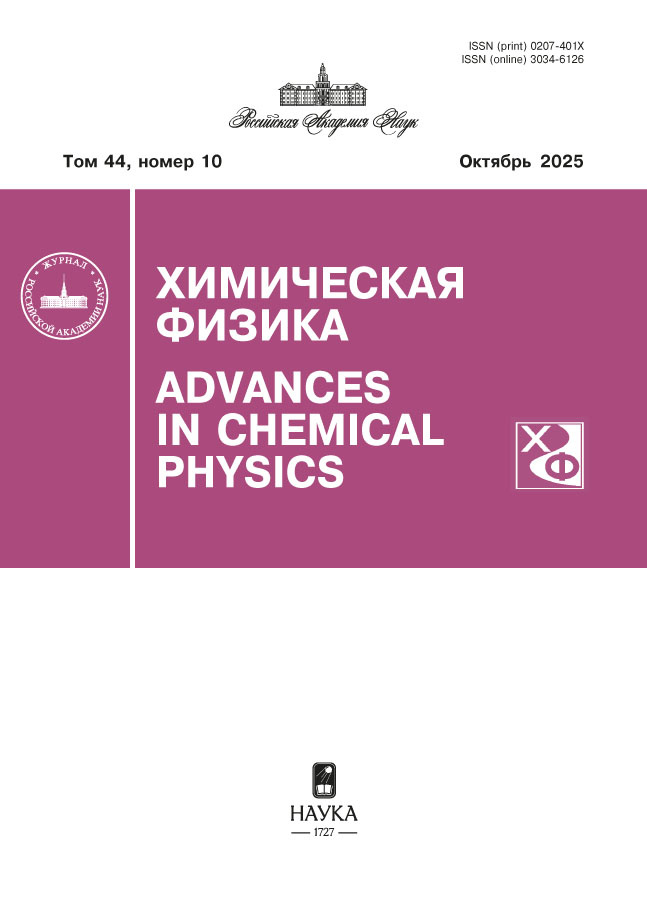Кинетические характеристики газификации уротропина в потоках азота и углекислого газа
- Авторы: Салганский Е.А.1, Глушков Д.О.2, Салганская М.В.1
-
Учреждения:
- Институт проблем химической физики Российской академии наук
- Национальный исследовательский Томский политехнический университет
- Выпуск: Том 42, № 3 (2023)
- Страницы: 58-62
- Раздел: Горение, взрыв и ударные волны
- URL: https://cardiosomatics.orscience.ru/0207-401X/article/view/674892
- DOI: https://doi.org/10.31857/S0207401X23030147
- EDN: https://elibrary.ru/NCSTBG
- ID: 674892
Цитировать
Полный текст
Аннотация
На основе данных термогравиметрического анализа и дифференциальной сканирующей калориметрии определены кинетические характеристики термического разложения уротропина в потоках N2 и CO2. Скорости нагрева образцов составляли 20, 60 и 90 К/мин. Значения кинетических констант скорости разложения уротропина определены по методу Киссинджера. При газификации в азоте энергия активации термораспада уротропина увеличивается со 106 до 139 кДж/моль в условиях роста степени превращения вещества. Значение предэкспонента также увеличивается с 0.35 · 109 до 145 · 109 с–1. Разложение уротропина протекает по экзотермической реакции с теплотой 368, 339 и 275 кДж/кг для скоростей нагрева 20, 60 и 90 К/мин соответственно. При газификации в углекислом газе энергия активации термораспада уротропина сначала увеличивается со 110 до 132 кДж/моль по мере увеличения степени превращения, а затем снижается до 120 кДж/моль. Теплота разложения уротропина в потоке СО2 составляет 382, 327 и 303 кДж/кг для скоростей нагрева 20, 60 и 90 К/мин соответственно.
Ключевые слова
Об авторах
Е. А. Салганский
Институт проблем химической физики Российской академии наук
Email: sea@icp.ac.ru
Россия, Черноголовка
Д. О. Глушков
Национальный исследовательский Томский политехнический университет
Email: sea@icp.ac.ru
Россия, Томск
М. В. Салганская
Институт проблем химической физики Российской академии наук
Автор, ответственный за переписку.
Email: sea@icp.ac.ru
Россия, Черноголовка
Список литературы
- Stepankova H., Swiatkowski M., Kruszynski R. et al. // Intern. J. Nanomed. 2021. V. 16. P. 4431; https://doi.org/10.2147/IJN.S304902
- Tseng K.W., Hsiao Y.P., Jen C.P. et al. // Sensors. 2020. V. 20. 2455; https://doi.org/10.3390/s20092455
- Виткалова И.А., Торлова А.С., Пикалов Е.С. // Науч. обозрение. Техн. науки. 2017. № 2. С. 15.
- Третьяков А.О. // Хим. пром-сть. 2005. Т. 82. № 11. С. 551.
- Сапченко С.А., Барсукова М.О., Нохрина Т.В. и др. // Изв. АН. Сер. хим. 2020. № 3. С. 461.
- Воробьёв В.В. // Аграрная Россия. 2010. № 2. С. 2.
- Xie Q., Zhang L., Yu X. et al. // Propell. Explos. Pyrotech. 2020. V. 45. № 12. P. 1859; https://doi.org/10.1002/prep.202000087
- Turhan H., Atalar T., Erdem N. et al. // Ibid. 2013. V. 38. № 5. P. 651; https://doi.org/10.1002/prep.201200162
- Salganskaya M.V., Zaichenko A.Yu., Podlesniy D.N. et al. // Acta Astronaut. 2022; https://doi.org/10.1016/j.actaastro.2022.08.039
- Аврашков В.Н., Метёлкина Е.С., Мещеряков Д.В. // Физика горения и взрыва. 2010. Т. 46. № 4. С. 36.
- Селезнев Р.К. // Физ.-хим. кинетика в газ. динамике. 2014. Т. 15. № 3. С. 4.
- Салганский Е.А., Луценко Н.А. // Хим. физика. 2022. Т. 41. № 3. С. 68; https://doi.org/10.31857/S0207401X22030116
- Белобровина М.В., Сенюшкин Н.С. // Актуальные пробл. авиации и космонавтики. 2013. Т. 1. № 9. С. 47.
- Salgansky E.A., Lutsenko N.A. // Aerosp. Sci. Technol. 2021. V. 109. 106420; https://doi.org/10.1016/j.ast.2020.106420
- Фролов С.М., Иванов В.С. // Хим. физика. 2021. Т. 40. № 4. С. 68.
- Михалкин В.Н., Сумской С.И., Тереза А.М. и др. // Хим. физика. 2022. Т. 41. № 8. С. 3; https://doi.org/10.31857/S0207401X2208009X
- Юрьев Б.П., Дудко В.А. // Хим. физика. 2022. Т. 41. № 1. С. 17; https://doi.org/10.31857/S0207401X22010174
- Tereza A.M., Medvedev S.P., Smirnov V.N. // Acta Astronaut. 2021. V. 181. P. 612; https://doi.org/10.1016/j.actaastro.2020.09.048
- Гольдберг В.М., Ломакин С.М., Тодинова А.В. и др. // Изв. АН. Сер. хим. 2010. № 4. С. 790.
- Sieradzka M., Mlonka-Mędrala A., Magdziarz A. // Fuel. 2022. V. 330. 125566; https://doi.org/10.1016/j.fuel.2022.125566
- Жуйков А.В., Глушков Д.О. // ХТТ. 2022. № 5. С. 45.
- Назин Г.М., Дубихин В.В., Казаков А.И. и др. // Хим. физика. 2022. Т. 41. № 1. С. 48; https://doi.org/10.31857/S0207401X22010125
- Shen H., Qiao H., Zhang H. // Chem. Eng. J. 2022. V. 450. 137905; https://doi.org/10.1016/j.cej.2022.137905
- Ramirez-Gutierrez C.F., Lujan-Cabrera I.A., Valencia-Molina L.D. et al. // Mater. Today Commun. 2022. V. 33. 104188; https://doi.org/10.1016/j.mtcomm.2022.104188
- Салганская М.В., Глазов С.В., Салганский Е.А. и др. // Хим. физика. 2008. Т. 27. № 1. С. 27.
- Rabinovich O.S., Malinouski A.I., Kislov V.M. et al. // Combust. Theor. Model. 2016. V. 20. № 5. P. 877; https://doi.org/10.1080/13647830.2016.1190034
- Miura K., Maki T. // Energy Fuels. 1998. V. 12. № 5. P. 864; https://doi.org/10.1021/ef970212q
- Zhang J., Wang Z., Zhao R. et al. // Energies. 2020. V. 13. 3313; https://doi.org/10.3390/en13133313
- Zhang J., Chen T., Wu J. et al. // Roy. Soc. Chem. Adv. 2014. V. 4. 17513; https://doi.org/10.1039/c4ra01445f
- Vyazovkin S. // Molecules. 2020. V. 25. 2813; https://doi.org/10.3390/molecules25122813
- Rao G., Feng W., Zhang J. et al. // J. Therm. Anal. Calorim. 2019. V. 135. № 4. P. 2447; https://doi.org/10.1007/s10973-018-7359-8
- Peng H.L., Chen L.P., Lu G.B. et al. // Hanneng Cailiao/Chinese J. Energetic Mater. 2016. V. 24. № 5. P. 497; https://doi.org/10.11943/j.issn.1006-9941.2016.05.012
- Салганский Е.А., Фурсов В.П., Глазов С.В. и др. // Физика горения и взрыва. 2003. Т. 39. № 1. С. 44.
Дополнительные файлы















